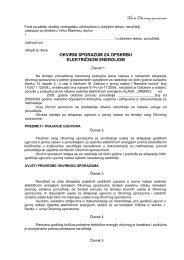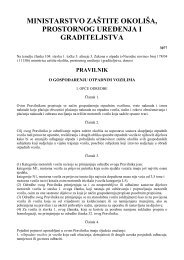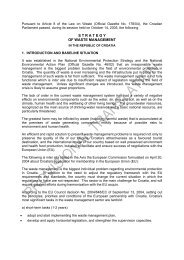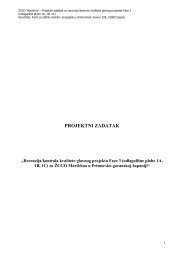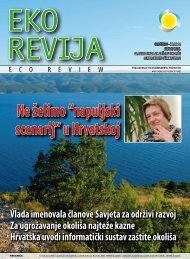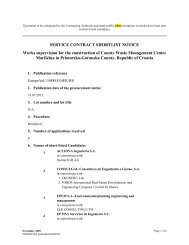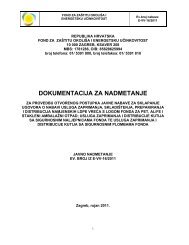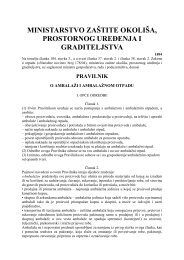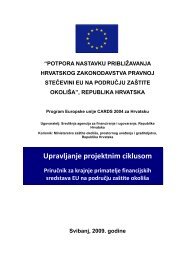Eko revija broj 15 - Fond za zaštitu okoliša i energetsku učinkovitost
Eko revija broj 15 - Fond za zaštitu okoliša i energetsku učinkovitost
Eko revija broj 15 - Fond za zaštitu okoliša i energetsku učinkovitost
Create successful ePaper yourself
Turn your PDF publications into a flip-book with our unique Google optimized e-Paper software.
Energy produced in such plants is also an<br />
important benefit of such investments -<br />
the aforementioned 70 biogas plants produce<br />
30 million cubic meters of gas or 60<br />
million kW of electricity, which is enough<br />
to power as many as 22 000 households.<br />
The heat produced in biogas plants is enough<br />
for 9000 homes. At the same time, the<br />
Croatian company Vrana, based in the vicinity<br />
of Biograd, plans to introduce new<br />
technologies worth 3, 5 million euro, with<br />
the financial help from the Munich based<br />
Croatian emigrants. That agricultural company<br />
farms 100 hectares of land, owns 900<br />
heads of cattle and a poultry farm with<br />
125 000 egg-laying hens.<br />
Iris Bajlo: Solar energy illuminated<br />
Zadar (page 57)<br />
The Zadar quay reconstruction project and<br />
the Sun Salutation installation, which is an<br />
integral part of the architectural design,<br />
are a perfect example of a union between<br />
the use of renewable energy sources<br />
and inspired design, which enhances the<br />
appearance of the historical town and<br />
the Adriatic coast. While highlighting the<br />
need for the integration of environmental<br />
awareness and modern technologies, this<br />
project points to a completely different<br />
view of energy. It also shows how playful<br />
imagination can achieve great architectural<br />
effects, while serving the practical<br />
requirements of a public space. A symbolic<br />
sun absorbs solar energy during the<br />
day and the collected energy powers an<br />
imaginative play of lights that follow the<br />
rhythm of waves and begin at nightfall.<br />
The unique combination of lights, sounds<br />
and waves may become an international<br />
attraction.<br />
Ružica Cindori: The Đurđevac Sahara<br />
(page 58)<br />
The Đurđevački Pijesci phenomenon has<br />
been described by Đurđevac teachers as<br />
early as 1900. It that time there still existed<br />
large areas of bare sand, moved about by<br />
winds that created shapes characteristic<br />
of desert landscapes, which is why the<br />
early chroniclers compared them to the<br />
“African Sahara”. The moving sand caused<br />
endless problems to local farmers<br />
because it would cover their fields or<br />
parts of villages. The Podravina Pijesci is a<br />
phenomenon that is disappearing under<br />
the human influence. Unfortunately, that<br />
means that its rich flora is fading away<br />
and many habitats are endangered or<br />
irrevocably transformed. The author of<br />
the book found that the area is a home<br />
to 529 butterfly species, out of which 27<br />
characteristic species inhabit exclusively<br />
sandy areas. Kranjčev believes that scientifically<br />
based projects must be designed<br />
and launched, aimed at the preservation<br />
and revitali<strong>za</strong>tion of biodiversity in that<br />
special reserve.<br />
Kruno Kartus: The highway uncovers<br />
Slavonian history (page 60)<br />
On the route of the Corridor 5C, which<br />
passes through Croatia as the 88,6-kmlong<br />
Beli Manastir - Osijek - Svilaj highroad,<br />
there are as many as forty-four<br />
registered archeological sites. The wealth<br />
of archeological finds is best illustrated<br />
by the fact that the Hrvatske Autoceste<br />
Company had to invest 72 million kuna in<br />
the preservation of those localities. That is<br />
half of the total funds invested in archeological<br />
research by the HAC since 2000. At<br />
the Štrosmajerovac site covering 100 000<br />
square meters, ten archeologists assisted<br />
by 60 workers are currently employed. At<br />
the sites, mostly local workers find jobs -<br />
at the moment a total of 200 people are<br />
employed. At the Štrosmajerovac site, the<br />
remains were unearthed of a late Bronze<br />
Age settlement and a <strong>15</strong>th century village<br />
of Užarevci, which once existed on histori-<br />
98 EKO REVIJA eco review<br />
cal, Austro-Hungarian maps. Three months<br />
ago, at the Franjevac locality covering the<br />
area of 36000 square meters, we discovered<br />
traces of a Bronze Age culture, dating<br />
from around 3000 BC. Pottery and bronze<br />
objects were unearthed, along with children’s<br />
skulls, remains of a man buried with<br />
two dogs and an exceptionally rare ceramic<br />
axe, probably ceremonial.<br />
Nebojša Jerković: Cultivation of citrus<br />
fruits in Croatia (page 61)<br />
The cultivation of tangerines was first<br />
introduced in Croatia in 1920, when the<br />
possibility of citrus fruits cultivation in<br />
Dalmatia was first realized. In his book<br />
Mandarina unšiu, 1956, author Milan Režić<br />
presents the chronology of introduction<br />
of the first tangerine cultivars along the<br />
Adriatic Coast. The first cultivars arrived in<br />
1933 from the Yokohama-Japan nursery<br />
garden to the port of Bar in Montenegro.<br />
After the planting of the first cultivars, that<br />
fruit easily spread across the Adriatic and<br />
in 1936 tangerine trees were planted on<br />
the island of Korčula, Dubrovnik, Split and<br />
the island of Hvar. Fertile farmland of the<br />
Neretva River Valley is perfectly suitable<br />
for organic production of high-quality Mediterranean<br />
and even subtropical fruits,<br />
and some vegetables. According to statistics,<br />
Croatia today has 70 000 hectares of<br />
orchards, which account for 2, 2% of total<br />
farmland in the country.<br />
Dražen Jambrović: Children in traffic<br />
(page 62)<br />
Children are a vulnerable group of road<br />
users. The number of traffic road victims<br />
is increasing around the world and it is<br />
particularly tragic that many of them are<br />
children. It is natural that every September,<br />
when the new school year begins, we<br />
pay special attention to the protection of<br />
children on our roads, especially first-graders<br />
who are attempting to cross roads<br />
independently for the first time. There<br />
are 46 286 children enrolled in first grades<br />
of Croatian schools - which means<br />
there are as many new road users. Aware<br />
that children are still developing skills that<br />
will make them responsible participants<br />
in traffic, the Ministry of the Interior introduced<br />
a series of both preventive and<br />
repressive measures aimed at increasing<br />
children’s safety. The most famous is the<br />
“Children in Traffic” campaign, running<br />
continuously since 1995. Over the past<br />
ten years, 263 children have been killed<br />
on roads and 17 427 were injured. Last<br />
year, 26 children lost their lives, which is<br />
a 45% increase as against the previous<br />
year when 18 children were killed. Out of<br />
the total number, 13 died as pedestrians,<br />
11 as car-passengers and 2 as drivers. The<br />
statistics show that children’s road safety<br />
has improved considerably since the launching<br />
of the campaign.<br />
Vanja Vitelj: Lavander (page 64)<br />
Lavender is a perennial, silvery flowering<br />
plant, used for over two thousand years. It<br />
originated from the western Mediterranean,<br />
where Greeks and Romans cultivated<br />
it for it medicinal properties. Today cultivated<br />
extensively for perfume, medicinal<br />
and ornamental purposes in several European<br />
countries, the plant reaches a height<br />
of 20 - 70 cm, has linear, lanceolate 3-5 cm<br />
long and 5 mm wide leaves covered with<br />
a velvety pubescence, and develops blue<br />
or purple flowers. During the Black Plague<br />
of 1665, bundles of lavender were hung<br />
extensively throughout London and its<br />
surrounds to sweeten the air from the<br />
smell of death, and also for its cleansing<br />
and anti-bacterial properties. Today it is<br />
used as a cure for anxious disorders, insomnia<br />
and stress. Lavender was also added<br />
to pillow fillings, because of their relaxing<br />
properties. In Croatia, lavender is most<br />
often encountered in Dalmatia, where it<br />
graces almost every garden.<br />
Kruno Kartus: Slavonians plant<br />
lavender (page 66)<br />
Several years ago, the Trampus family<br />
discovered they had ideal conditions for<br />
lavender cultivation and began a pioneering<br />
endeavor - cultivation of lavender<br />
near Belišće, on a first lavender farm in<br />
Slavonia. “Wide fields, rich soil, pleasant<br />
wind blowing form Krašica and, most<br />
importantly, enough sun throughout the<br />
day, are ideal conditions for lavender”, explained<br />
Vesna Trampus as she prepares for<br />
the second harvest this year. In 2005, the<br />
family planted three and a half thousand<br />
cultivars on two hectares of previously<br />
deserted farmland, which was therefore<br />
free of pesticides, and treated it only with<br />
natural soil improvers. Thanks to the safe<br />
market and stable prices, the Trampus’<br />
now have 17 thousand cultivars that yield<br />
their scented flowers twice a year.<br />
Edita gregurić-Cvenić: Agave (page 67)<br />
Agavaceae is a family of plants that includes<br />
many well-known desert and dry<br />
zone types such as the agave. Lice all succulents,<br />
agave store water in their thick leaves.<br />
Although their leaves are spiky, they<br />
do not belong to the Cacti, but to the order<br />
of flowering plants Asparagales. They<br />
flower only once - after some ten years.<br />
The plants have a large rosette of thick<br />
fleshy leaves generally ending in a sharp<br />
point and with a spiny margin; the stout<br />
stem is usually short, the leaves apparently<br />
springing from the root. During flowering<br />
a tall stem or “mast” grows from the<br />
center of the leaf rosette and bears a large<br />
number of flowers. After development of<br />
fruit the original plant dies, but suckers are<br />
frequently produced from the base of the<br />
stem, which become new plants. Its leaf<br />
and tincture have medicinal properties.<br />
Roman Ozimec: Dinara goats (page 68)<br />
Goats have always been the most common<br />
domestic animal in the Dinaric karst<br />
region, alongside sheep. They have left<br />
a mark on many aspects of human lives<br />
- goat paths are often the only passages<br />
across that karst wasteland and water<br />
was carried in goatskins. In remote villages,<br />
beds used to be one meter above the<br />
ground so that kids could be placed beneath<br />
them for the first few nights after their<br />
birth. Goats eat almost about a hundred<br />
plants and are perfectly adapted to barren<br />
karst, difficult terrain and harsh weather<br />
conditions. Across the Dinarides, a characteristic<br />
breed has developed called the<br />
“Dinara multicolored goat”. In mid-19th<br />
century, there were almost 400 000 goats<br />
in Dalmatia, but their number has dwindled<br />
through the decades, so in the early<br />
20th century there were only 200 000 and<br />
in 1939 only 1<strong>15</strong> 000 goats.<br />
Krunoslav Rac: Brown bear (page 70)<br />
According to estimates, the brown bear<br />
population in Croatia numbers 600 - 1000<br />
animals. For bears, it is food that dictates<br />
the life style and distribution range. Bear<br />
is by nature an opportunist who will eat<br />
anything with any nutritional value. That<br />
quality enables it to inhabit barren mountain<br />
areas. As opposed to other large<br />
mammals, bears have developed a characteristic<br />
strategy for survival in harsh,<br />
winter conditions. When the supply of<br />
food in nature diminishes, they go into<br />
hibernation! When thick layer of snow<br />
covers the land and temperatures fall far<br />
below the freezing point, they take shelter<br />
in their dens, where a cozy bed awaits<br />
them, made of leaves and twigs collected<br />
before winter. Their dens are always small<br />
so that the bear could use as little as possible<br />
energy for keeping warm. Hibernation<br />
is a state of inactivity and metabolic<br />
depression in animals, characterized by<br />
lower body temperature, slower breathing,<br />
and lower metabolic rate. Bears do<br />
not have real natural enemies. Very rarely<br />
does it happen that a pack of wolves attacks<br />
a bear-cub. They are usually simply<br />
too large and too strong for other animals.<br />
Unfortunately, neither strength nor size<br />
helps against a bullet.<br />
Dora Belamarić: The town of Bakar<br />
(page 72)<br />
Bakar is located on an amphitheatre-shaped<br />
slope above the Bakar Bay, <strong>15</strong> km<br />
southeast of Rijeka. The town center was<br />
designated a cultural monument in 1968.<br />
The first settlement dates from the late<br />
Bronze Age and during the Greco-Roman<br />
period it spread along the coast. The 20th<br />
century brings the intensive industriali<strong>za</strong>tion<br />
of the Bakar Bay and the town itself,<br />
which resulted in devastation of its natural<br />
resources. After the long period of misdirected<br />
industrial development, Bakar is<br />
again flourishing, as the awakened environmental<br />
awareness has paved the way<br />
to the development of sustainable tourism.<br />
The main reason is the demolition of<br />
the notorious coke-plant in Bakar. Remediation<br />
process will cover the surface area<br />
of over 5500 square meters contaminated<br />
with tar and oil, and the depth of 0, 8 - 3,<br />
5 meters. The Head of the Environmental<br />
Protection and Energy Efficiency Fund<br />
Vinko Mladineo announced that the Fund<br />
would invest 18 million kuna in the Bakar<br />
remediation project, which would undoubtedly<br />
contribute to the continuation of<br />
the tourism development in Bakar and its<br />
sustainable economic development.



